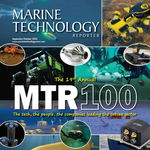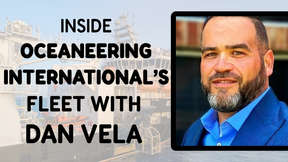Seafloor Mapping And Imaging
Knowing the depth of the seafloor and locating its hazards is of the main interest to shipping. The first maps were produced to identify the near-shore hazards and only in the nineteenth century sounding expeditions in deep water were organized.
The first primitive maps have been made through correlating successions of single soundings realized using weighted lines. These lines were lowered into the water and people noted when the tension on the line slackened. Depth was equal to the amount of line paid out.
First used during World War I, the underwater sound projectors called “sonar” gave the first impulse to the seafloor mapping/imaging. In 1920, a team from the Coast and Geodetic Survey presented one of the first detailed maps of the ocean floor, showing the extent of the canyons of the East Coast of the United States into the deep water.
Sonar comes from Sound Navigation and Ranging, and detects underwater located items using sound waves. The technique is similar with the radar system, based on the reflection of radio waves from objects in the open space. There are two types of sonar systems: active and passive.
The regular set of an active sonar system creates an ultrasonic pulse, known as a ping pulse, which travels using the sound waves and comes back if hitting something. The reflected pulse is registered by a specialized hydrophone, which also is the main component of the passive sonar. The passive sonar procedure is to capture and register the sounds produced by submersed items, either submersibles or marine fauna. The two seafloor mapping/imaging systems are used to determine the location and range of any objects along its path.
During World War II, sonar and electronic data processing seafloor mapping/imaging technologies improved and made possible precise measurements of the seafloor relief in the great water depths. The first maps of the deep-sea trenches and mid-ocean ridges appeared and provided information for the plate tectonics which explain the formation of Earth surface, including the underwater zones, like mid-ocean ridges, trenches, mountain ranges and the “ring of fire” around the Pacific.
Scientists and many others are interested in both knowing the shape of the seafloor and its composition. While the depth is measured through timing the sounds going to and returning from the seafloor, its composition can be estimated through the “strength” of the returned sound. When the sound pulse encounters a mud seafloor, it will be mostly absorbed, but in the case of a rock bottom it will be mostly reflected back to the sonar. The modern seafloor survey systems are able to measure the depth and the relative composition of the sea bottom.
Multi-beam sonar
A limitation of this seafloor mapping/imaging system is its sounding immediately below the ship. To realize the map of a region, you have to interpolate data from a series of lines of measurements. Even with the help of powerful computers this is a laborious job, but the civilian scientific community had to use this basic technology until 1970s.
Discovered in 1960,“multi-beam sonar” was initially used by U.S. Navy. It consists of arrays of sonar projectors that produce soundings along the track and also across it, and for significant distances, resulting in a swath of soundings. The technology steadily improved along the development of computing systems. The multi-beam sonar seafloor mapping/imaging systems can also benefit of information from the geographic positioning navigation systems and advance computer graphics and are now able to provide us with a complex and detailed view of the seafloor and its texture.
Multi-beam sonar uses the energy of the sound to record topographical data to produce reliefs mapping the seafloor. The system sends beams of sound to the ocean floor and measures the time between transmission and reception of the same sound pulse. The equipment for multi-beam sonar is attached to the hull of a vessel that can travel as quickly as 10 knots, is very stable and generates data in near real time; these data can be processed quickly into usable maps.
But it has limitations too. It gathers data about water depth using the sound which speed depends on the water depth. Furthermore, the footprint of the sound beams increases along its way through water, as does the spot of a flashlight in open space. This spreading of the sound beams with depth decreases the resolution and accuracy of the map it is used to generate. The map resolution also depends on the frequency of the sound. But in deep waters high frequency sounds quickly dissipate and loses energy, attenuate. This means that deep water maps cannot be very precise.
Side-Scan Sonar
Another seafloor mapping/imaging scientific marine geophysical technique is the side-scan sonar system. It is widely used to study the topography of the bottom of lakes or rivers or the marine life of the deep sea areas. It also provides good information for nautical measurements or to identify the submersed barriers or objects. Combined with the appropriate processing capabilities, the side-scan sonar system can be used to view what is or happens above the water surface.
These systems are towed as arrays on cables and can cover a wide swath of sea undersurface. The arrays of sound projectors emit sound signals under low angles. The results of the records are the acoustic “shadows” that are cast. It can detect very subtle features and can cover from hundreds of meters to kilometers of seafloor. They are also a good alternative method of mapping the texture of the water bottom but also depend on the frequency of the sound projectors. In order to provide very high resolution images the sound frequency should be high, up to 500 kilohertz and more. But the use of such high frequencies lessens the range of the images.
While acting in shallow waters, the transducer of the side-scan is not towed but connected to the boat and can be easier controlled. It plays a key role in the shipping oil and gas industries: provides valuable information for ships and crews related to the seabed or ocean floor underneath, real time investigation for the maintenance of pipelines and submarine cables. The information is provided along bathymetric soundings collecting under-bottom data revealing the shallow composition of the seafloor.
A variety of side-scan systems are widely used by different people: scientists, fishermen, ocean or oil engineers. The navy also uses it to gather information of all interest, including intelligence gathering.










![Aerial view of the Rock Islands and coral seascape at the Republic of Palau. [Photo credit: The Nature Conservancy]](https://images.marinetechnologynews.com/images/maritime/w66h66c/aerial-view-rock-165050.jpg)




 August 2025
August 2025



